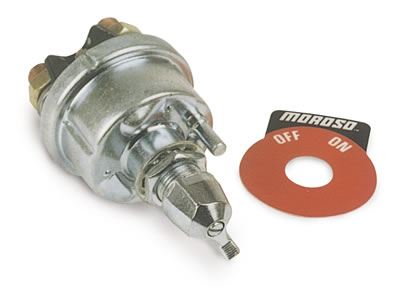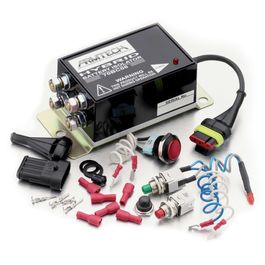A mechanical switch operated by a rods and/or cables is a proven way of doing things. That said, I’m not sure that 20GBP is going to get you a reliable switch.
All that matters is if the car can be isolated when required and device failure is just one small branch on the failure tree. If you roll the car and the mechanical switch is inaccessible or if you’re knocked out and there is no one to turn the switch off does it matter that the switch didn’t fail… nope. Technology has come a long way to mitigate the solid-state device failure modes and remove many of the situational failure modes that exist with mechanical switches.
MECHANICAL SWITCH PROS:
- Pretty much fail proof (so long as you don’t buy a junk knockoff)
- Inexpensive
- Zero parasitic draw
MECHANICAL SWITCH CONS:
- There are typically at most two ways to isolate the battery; one inside the cockpit and one in an approved location on the exterior of the car. If the driver is knocked out it’s up to someone on the exterior. If the car rolls it will land on one of four sides. If it lands on the driver’s side, the switch is inaccessible. Same if the driver’s side is pinched up against a barrier.
- Proper installation takes thought and some effort. The switch should be located next to the battery with cables or rods run to the disconnect locations. It looks like Neil did it properly. However, I’ve seen multiple builds where the positive cable is run long distances to one of the shutoff locations. This adds weight, resistance and the length of positive cable that could potentially short.
- The only way to isolate the battery is via the driver or someone outside the car who knows what to do.
SOLID STATE CONS:
- More expensive
- The device could fail
- One milliamp parasitic draw in standby mode
Neil, points out that if the MOSFET fails you could lose the ability to isolate the battery. Yep, that would be a massive risk if you built one in your garage or bought a poorly engineered unit. My unit constantly monitors temperature, voltage and current on both sides of the device, and checks for a short-circuit condition before activating. It’s theoretically possible for it to fail closed, but that’s remote.
Randy gives a thumbs down because people might not know what to do with the buttons. These are FIA/MSA/etc. certified devices which have been on the market for a while so if that’s an issue, I’m not sure I want to run at that track. That said, one of the circuits on the MSEL device would allow you to use the familiar “flag” switches which might be a good idea.
I don’t see 297 days to drain the battery as being an issue. If your car is going to sit that long you have a bunch of other storage considerations. You could also install a mechanical switch (see paranoid case below) to eliminate that issue.
SOLID STATE PROS:
- Easier to install. It’s trivial to locate it directly next to the battery and low-current switch wire is infinitely easier to route than cables and rods.
- Depending on the device, you can pretty much use whatever switch you want.
- You can have as many kill switches as you want. If I had a dedicated track car, I’d have four; cockpit, left side, right side and rear
The MSEL unit that I have has CAN bus integration which has the following benefits:
- Disconnect command. This allows the use of an inertial measurement unit (IMU) to detect a collision or rollover event and send a disconnect command.
- Instrumentation of current flowing to/from the battery, voltage at the Master Relay output and voltage at the battery. This data is used to prevent a failure, but it can also be logged which is really useful when you have multiple electric fans, fuel pumps, cooling pumps, power-assisted steering, etc. and you want to figure out what’s going.
At races where every corner is manned maybe someone gets to you in time, maybe they don’t. If you roll the car or have it pinched against a barrier, maybe the external switch is accessible, maybe it isn’t. But what about a track day that isn’t fully staffed or when you’re on the street as many of us are? Who’s going to shut the car off if you’re knocked out? In the case of a flip or roll, the IMU will likely disconnect BEFORE there is an impact. In the case of an impact it’s certainly going to turn things off quicker than the driver could. The speed of disconnect might not be a big issue for a carbureted car, but it certainly is with an injected car with a 1,800 HP capable fuel pump.
My use case is mostly street with some track so the automatic disconnect on roll over or impact outweighs the small risk that the device might fail. It seems that many race teams have come to similar conclusion for their use cases. I listed a paranoid approach below that provides the benefits of both… I wonder if anyone has done it.
Recommendations for three approaches:
Mechanical Approach
- Purchase a proper switch from a place like Pegasus Auto Racing. eBay and Amazon aren’t your friend for this type of purchase because there are many knock-off imitation switches out there.
- Take the time to install it properly (i.e., switch is located next to the battery)
Solid-State Approach
- Purchase one with appropriate technology to mitigate chance of failure
- Integrate with an IMU (e.g., automatic isolation on impact or roll over)
Paranoid Approach
- Install a mechanical switch
- Install a solid-state device between the mechanical switch and the battery. Do not wire any switches to the device.
- This provides the same shut-off reliability because the switch and the device are in series. The device provides logging and automatic disconnect in the case of an impact or roll over. The mechanical switch also allows you to eliminate all parasitic draw.








